8 Ways to Stop Brakes From Squeaking Without Taking Tire Off? [2023]
![a pic about 8 Ways to Stop Brakes From Squeaking Without Taking Tire Off? [2023]](https://phoenixcarmag.com/wp-content/uploads/2023/09/8-Ways-to-Stop-Brakes-From-Squeaking-Without-Taking-Tire-Off-2023.jpg)
Brakes are one of the important components of any vehicle, which ensures safety and smooth driving. However, when the squeaking starts, it can be both very annoying and cause concerns.
This article is going explore the reasons that cause brake squeaking and provide solutions on how to solve the problem without removing the tire.
So, if you want to know how to stop brakes from squeaking without taking tire off then just keep reading.
You might also enjoy:10 Key Differences between 4.3 and 4.3 Vortec [2023]
How To Stop Brakes from Squeaking Without Taking Tire Off: 8 Ways
1- Replace Worn Brake Pads
Solution: One of the most effective ways to solve the brake squeak problem is to replace worn-out brake pads. Brake pads are designed to provide friction, allowing your vehicle to lose speed and slow down or stop. As time passes, this friction causes the pads to wear down.
When they become too thin, it’s important to replace them in order to ensure the safety and efficiency of your braking system.
Cause: The wear and tear of the brake pad is the main reason behind this solution. As they wear down because of the constant friction, metal-on-metal contact can happen, leading to an annoying squeaking noise.
2- Regularly Clean Your Brakes
Solution: In order to obtain an optimal brake performance and prevent the usual squeaking you must clean your brakes regularly. A brake cleaner spray can be a good option helping remove dust, debris, and other contaminants. As for stubborn dirt, a soft brush or cloth can be effective. Be sure to make certain the brakes are cool before cleaning.
Cause: The buildup of dust, small debris, and other contaminants on the brake pads and rotors can lead to squeaking noises when the brakes are used.
3- Address Rust on Brake Rotors
Solution: Addressing the rust on your brake rotors promptly can be helpful. For superficial rust, simply driving the car and applying the brakes a few times can help you scrape the rust off. For more serious rusting, you might want to consider replacing the rotors or having them professionally resurfaced.
Cause: Brake rotors can develop rust when they are exposed to moisture, especially after rain or when the car is being washed. This rust can cause a squeaking noise when the brakes are applied.
4- Sand Glazed Brake Pads and Rotors
Solution: Overheating can be a problem for brake pads and rotors and cause them to become glazed. You can remove the glaze by sanding the surface of the brake pads and rotors, in order to restore the rough texture needed for optimal braking experience.
Cause: Glazing occurs when there are high temperatures put on brake pads and rotors, they tend to cause the brake pad material to get hard and become shiny. This can be a result of excessive braking or using brakes continuously over long slopes.
You might also enjoy: How Many Brake Pads Come In A Box? [2023]
5- Ensure Proper Alignment of Brake Components
Solution: By regularly inspecting your brake components you can make sure that they are aligned correctly. If you suspect that they are improperly adjusted, it might be worth seeking technical assistance. Proper alignment ensures that all parts work in harmony and prevents any unintended friction and squeaking from happening.
Cause: Misalignment can happen because of various reasons, such as improper installation, accidents, or natural wear and tear. In this case, the components are going to rub against each other, leading to a squeaking sound.
6- Opt for High-Quality Brake Pads
Solution: Choosing high-quality brake pads from reputable manufacturers might be expensive but they can compensate the price in the long run. While they might have a higher forward cost, they offer better performance, and longevity, and are less likely to cause squeaks.
Cause: Some cheaper, lower-quality brake pads can be made out of poor-quality materials that can be found in the market but along with being cheaper they are riskier to squeaking too. These materials might not handle heat and friction as well as their higher-quality counterparts.
7- Lubricate Brake Components
Solution: Regularly lubricating the contact points in your brake parts using a high-temperature brake grease or lubricant. This process can let you make sure they have smooth operation and help reduce the chances of squeaking sounds. Keep in mind to refrain from getting any lubricant on the friction surfaces.
Cause: As time goes by, the lubrication on brake parts tends to wear off, causing a rise in friction and squeaking. This is mostly true for the contact points, like the back of the brake pads and caliper pins.
8- Check Brake Pad Wear Indicators
Solution: Regular inspection of your brake pads for wear indicators. These parts are designed to produce a squeaking sound when the pads need to be replaced. If you hear this sound, it’s a clear sign that it’s time to change your brake pads.
Cause: Most brake pads come equipped with wear measurements as a safety point. When the pads wear down to a certain point, these indicators make contact with the rotors and produce a squeaking noise in order to warn the driver.
6 Common Reasons Why Brakes Squeak
1- Worn Brake Pads
Brake pads are a fundamental part of the braking system. As time goes on, through regular use, these pads wear down due to the stable friction they experience when you use the brakes.
As they wear down, the thickness decreases, and they can get as far as where the built-in wear indicators start to make contact with the brake rotors. These indicators are designed to produce a squeaking sound as an alert to the driver that the pads need replacement.
When the brake pads turn too thin, the risk of metal-on-metal contact goes up. This not only produces a squeaking sound but can also cause harm to the rotors.
It’s important to check the thickness of your car’s brake pads and replace them accordingly when they reach their minimum standard thickness. Driving with worn-out brake pads can jeopardize your security and lead to a much more expensive repair in the future.
2- Accumulation of Dust and Debris
The braking system is one of the units that is exposed to the external environment, which means it’s prone to collecting dust and debris. throughout time, this buildup can get trapped between the brake pads and rotors.
When the brakes are used by the driver, this trapped debris can cause a squeaking or grinding sound due to the created friction.
Routine cleaning and maintenance can help in order to stop exorbitant accumulation.
Using a brake cleaner can be an effective way to remove dust and debris, making sure a much smoother and noise-free operation. It’s also a good idea to avoid driving through areas with redundant dust or debris in order to minimize the buildup.
You might also enjoy: Can A Weak Alternator Cause Poor Engine Performance? 2023 Answer
3- Rust Formation on Brake Rotors
Brake rotors are made of metal which makes them vulnerable to rust, especially after being exposed to moisture. After a rainy day or even because of morning dew, a skinny layer of rust can form on the surface of the rotors.
When the brakes are applied, the brake pads scrape against this rust, producing a squeaking noise.
While a slime amount of rust is normal and often gets scraped off with regular brake use, extreme amounts of rust can be a serious concern. If you live in a humid environment or near the beach, it might be a good idea to check your rotors regularly for signs of exorbitant rust and try considering the use of rust-resistant rotors.
4- Glazed Brake Pads and Rotors
Brake glazing happens when the brake pads and rotors overheat.
This overheating causes the resin in the brake pads to break down and form a shiny, glazed layer on the surface of the pads and rotors.
This glazed surface helps to reduce the friction between the pads and rotors, leading to reduced braking capability and a squeaking sound.
Several factors can chip into brake glazing, including aggressive driving, continuous riding of brakes, or using brake pads with low quality.
In order to prevent glazing, it’s essential to allow your brakes to cool down after heavy use and consider using high-quality brake pads that are designed to handle higher temperatures.
5- Misaligned Brake Components
Proper alignment of all brake parts is an important factor in order to have a smooth operation.
If any part of the braking unit is misaligned, it can provoke parts rubbing against each other in ways they shouldn’t. This unwanted friction can produce a squeaking noise.
Misalignment can happen because of a vast variety of reasons, which include improper installation, accidents, or natural wear and tear.
Scheduled inspections can be helpful in order to try to identify and correct any alignment problems, in order to ensure all components, work in harmony and without producing unwanted noises.
6- Use of Low-Quality Brake Pads
Not all of the brake pads are created equal. Some are cheaper, low-quality brake pads that are made of low-quality materials that have a tendency to produce noise.
These materials might not be able to handle heat and friction as effectively as higher-quality doppelgangers, leading to unwanted squeaking or other noises.
It’s always endorsed to invest in quality and in this case quality brake pads from reliable manufacturers. Although they may cost a little more upfront, they offer better performance, and longevity in the long run, and are less prone to causing unwanted sounds.
How to remove tire in 7 steps
Exploring the universe of car maintenance can usually lead us down paths we’d rather not step into. Although you might have been searching for ways to address the brake squeak problem without the hassle of tire removal, the reality is a bit more hands-on.
Sometimes, to truly get to the source of an issue, we need to dive deeper than surface-level fixes.
Don’t be afraid, though! You might think removing a tire sounds daunting, but with the right guide, it can become an easy task.
Let’s guide you through the simple process of safely and efficiently removing your car’s tire.
1- Safety Precautions
Explanation: Park your vehicle on a flat, stable surface and stay away from traffic. Engaging in the parking brake can help you to make sure the vehicle remains stationary.
2- Assemble Necessary Tools
Explanation: Gather all the crucial tools like the car jack, a lug wrench, and if available, wheel chocks or large stones
3- Slightly Loosen the Lug Nuts
Explanation: Prior to lifting the vehicle, you want to make sure to use the lug wrench in order to slightly loosen each lug nut on the tire. Don’t remove the lug nuts completely at this stage.
4- Lift the Vehicle
Explanation: Position the car jack under the vehicle’s jacking point (you can refer to the manufacturer’s manual if you are unsure about the position) and raise the vehicle off the ground so that the tire no longer touches the surface.
5- Remove the Lug Nuts
Explanation: At this time that the tire is elevated, you can fully remove the previously loosened lug nuts by using the lug wrench.
6- Take Off the Tire
Explanation: Free the tire from the wheel hub by grasping the tire on the other side and gently pulling it towards you until it comes loose. Set it aside in a secure location.
You might also enjoy: Car Sputters After Getting Gas: Top 10 Causes And Solutions
7- Inspect the Hub
Explanation: Before replacing the tire or attempting to install a spare, first try to inspect the wheel hub and brake parts for any visible damage or debris.
How To Lube Brake Pads
Lubricating the brake pads can be an important step in maintaining your vehicle’s braking system. Proper lubrication assures smooth operation, reduces sounds, and extends the lifespan of the brake parts. Here’s how to lube brake pads one step at a time guide :
1- Safety First
Before doing anything, make sure that the vehicle is on a flat surface and the parking brake is engaged too. Wearing gloves and safety glasses in order to protect your hands and eyes from dirt and debris is also advised by experts.
2- Gather Necessary Supplies
You are going to need high-temperature brake grease or lubricant (advised in the manufacturer’s manual ), a clean cloth, and a small brush or applicator.
3- Remove the Tire
You must follow the crucial steps in order to remove the vehicle’s tire safely, exposing the brake parts.
4- Inspect the Brake Pads
Remember to inspect the brake pads for any sign of wear and tear before applying the lubricant. If the brake pads are excessively worn out, consider replacing them.
5- Clean the Brake Pads
Use a clean cloth in order to wipe away any dirt, dust, or debris from the brake pads.
6- Apply Lubricant
Try using a small brush or applicator, to administer a thin layer of brake grease to the back of the brake pads. This is when the brake pads make contact with the caliper piston. Be sure to avoid getting lubricant on the friction surface of the pads.
7- Reassemble the Brakes
Once you lubricated the target positions you must reassemble any parts you may have removed and replace the tire.
8- Test the Brakes
Before starting to drive, test the brakes by pressing the brake pedal a few times to ensure everything feels right. You must also start with a slow drive to test the brakes in a controlled environment.
Remember, although the process of lubricating brake pads can reduce noise and improve performance, it’s important to use the right type of lubricant and apply it correctly in order to avoid any potential issues.
How WD40 Can Stop the Brake from Squeaking?
WD-40 is an adaptable product famous for its lubricating and rust-preventing properties. But can it also be responsible for stopping the brakes from squeaking? Let’s dive into this part:
WD-40 Properties
WD-40 is actually a water-displacing spray that is designed in order to prevent rust and free up stuck or rusted components. It has lubricating properties, but it’s not one of the high-performance lubricants.
You might also enjoy: Car Rattles When Idle: 17 Causes And Solutions [2023]
Temporary Solution
Spraying WD-40 can help by providing a provisional fix for squeaky brakes. It can displace moisture, decrease the amount of rust, and provide a short-term solution to this problem.
Not a Long-Term Fix
At the same time WD-40 might stop the squeaking sound for the time being, it’s not a long-term solution. Brakes generate a large amount of heat, and WD-40 can evaporate under such conditions and result in it losing its effectiveness.
Potential Risks
Applying WD-40 on brake parts has proven to be risky. If it gets on the brake pads or rotors, it can reduce the friction needed for an effective brake, tending to decrease brake optimal performance and potential safety dangers.
Correct Application
If you choose to use WD-40, ensure that it is applied away from the friction surfaces. It is important to focus on the back of the brake pads or other non-friction parts:
Alternative Solutions
For a more enduring solution to brake squeaks, you must consider using dedicated brake lubricants or greases intended to withstand the high temperatures and pressures applied during the braking process.
Lastly, although WD-40 can provide a quick fix for the brake squeak noises, it’s important to use it with caution and understand the limitations that come with it.
How to Clean My Brake Pads?
one of the important subjects regarding optimal braking performance is the clean brake pads. As time passes, brake pads can accumulate dust, debris, and other contaminants which is going to affect their efficiency. Here’s how to clean the cars brake pads:
Safety Precautions
Ensuring that the vehicle is on a flat surface with the parking brake engaged is a must. Wearing safety gloves and glasses is an important step to avoid unwanted incidents.
Remove the Tire
In order to access the brake pads, first you’ll need to remove the vehicle’s tire.
Inspect the Brake Pads
Before cleaning anything, be sure to check the brake pads for wear. If they’re too worn out, it’s best to replace them instead of cleaning them.
Use a Brake Cleaner
Brake cleaners are specially formulated to dissolve and remove grease, oil, and brake dust. Try spraying the cleaner generously on the brake pads and rotors and let it sit for at least a few minutes.
Brush Off Debris
You can gently scrub the brake pads to remove any stubborn dirt or debris with a soft bristle brush try to avoid using metal brushes as they can damage the brake pad surface.
You might also enjoy: Mitsubishi Outlander PHEV Problems – [2023 Update]
Wipe Clean
Use a clean cloth to wipe away any residue or loosened debris after you are done brushing.
Rinse (If Necessary)
There are some brake cleaners that might require rinsing with water. If it is so, you can use a hose to gently rinse the brake parts. Ensuring that they’re thoroughly dry before reassembling.
Reassemble and Test
Once it is cleaned, you must start reassembling any components you might have removed, replace the tire, and make sure to test the brakes in order to make sure they’re functioning correctly and optimally.
Regular cleaning can be helpful in order to extend the lifespan of your brake pads and make certain of consistent braking performance. Always use products designed for brake cleaning to avoid potential damage reduced efficiency or even safety hazards.
FAQs
- Why do my car’s brake pads make squeaking sounds?
New brake pads might squeak because of a lack of lubrication or improper fitting. Be sure to check that they are installed correctly and lubricated well.
- How often should I clean my brake pads?
It’s good to inspect and clean them frequently, especially if you drive in dusty conditions.
- Can I use any lubricant for my brakes?
No, always try to use lubricants designed for brakes as they have the ability to withstand the heat generated during braking.
- Is WD40 safe for brakes?
While it can temporarily stop the squeaking, it’s not recommended for long usage as it can affect brake efficiency.
- How often should brake fluid be replaced?
It’s suggested to replace brake fluid every two years or as per the vehicle guidelines provided by the manufacturer.


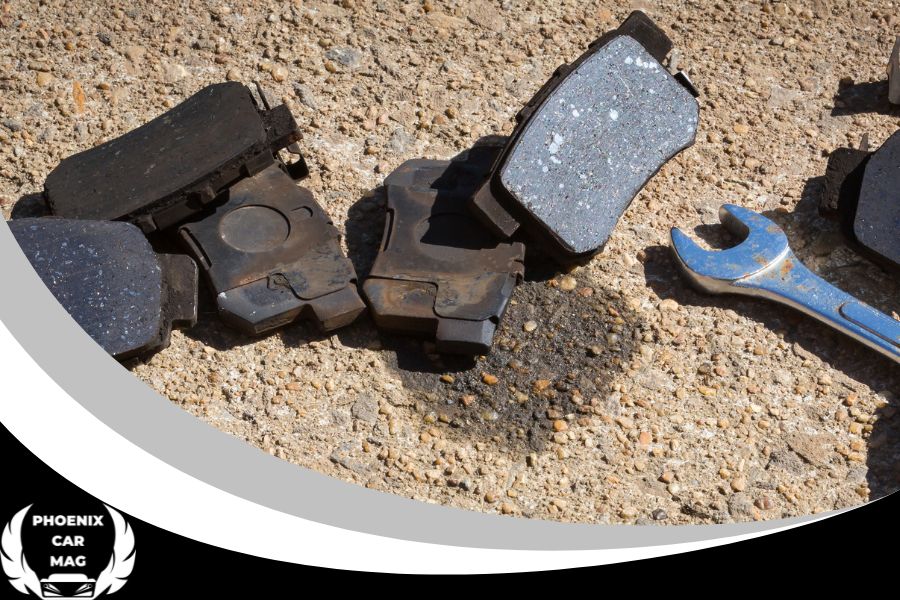
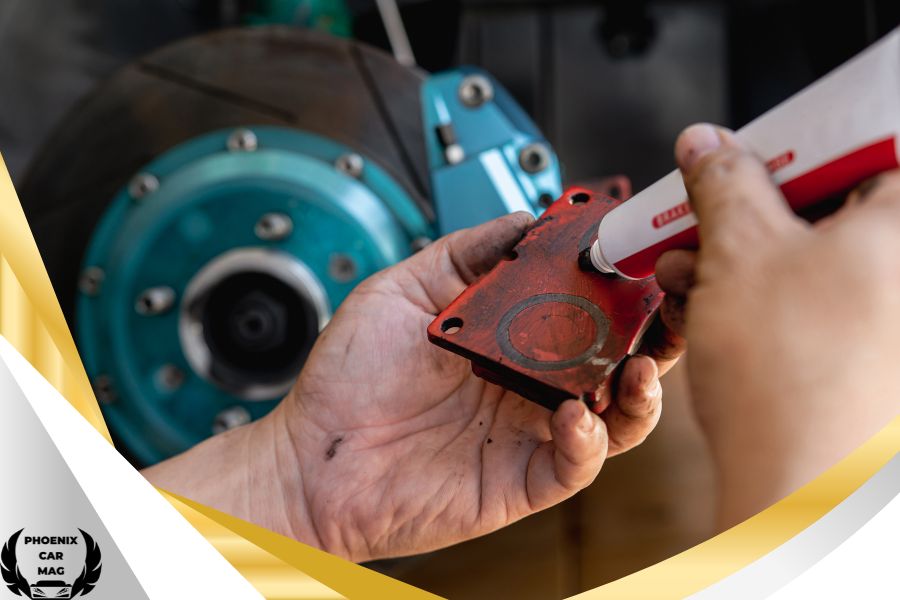
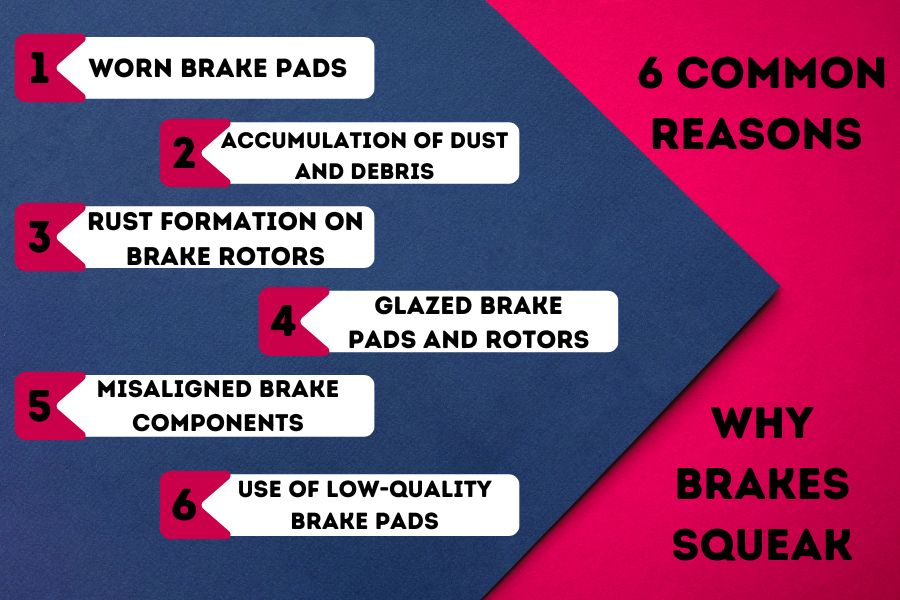
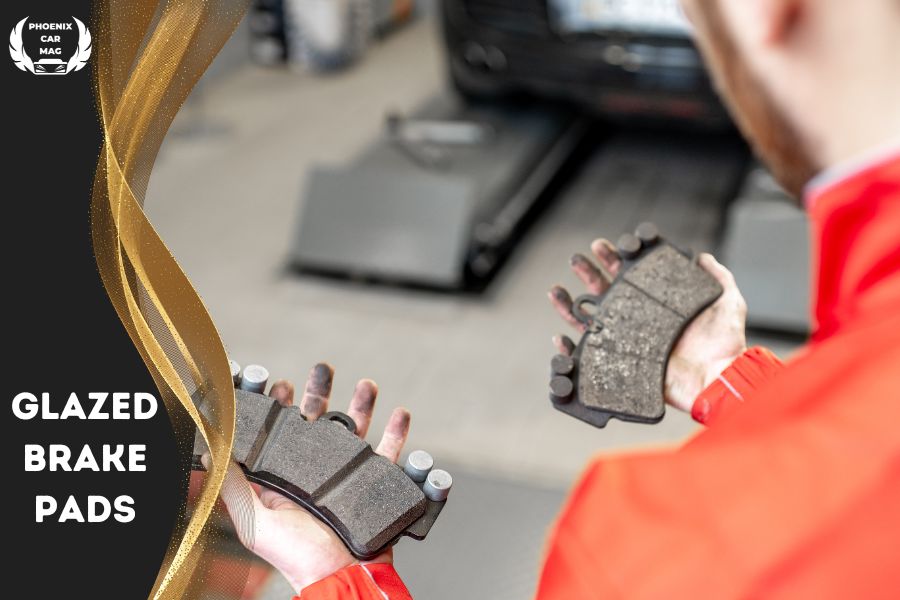
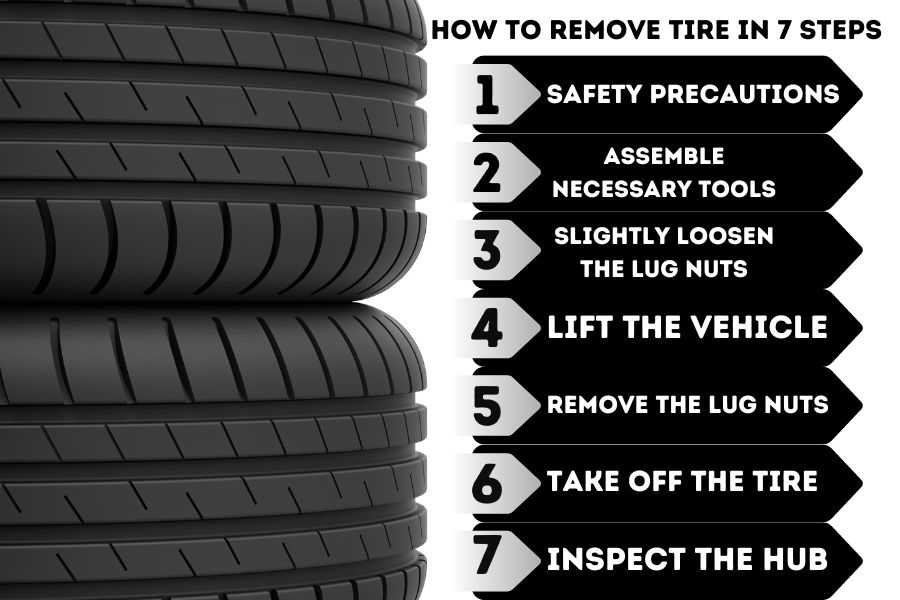
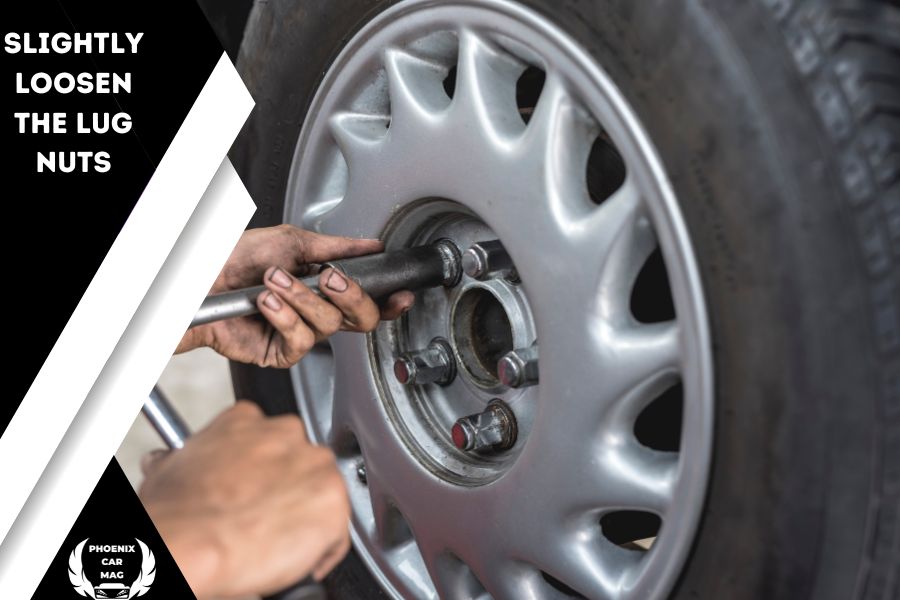
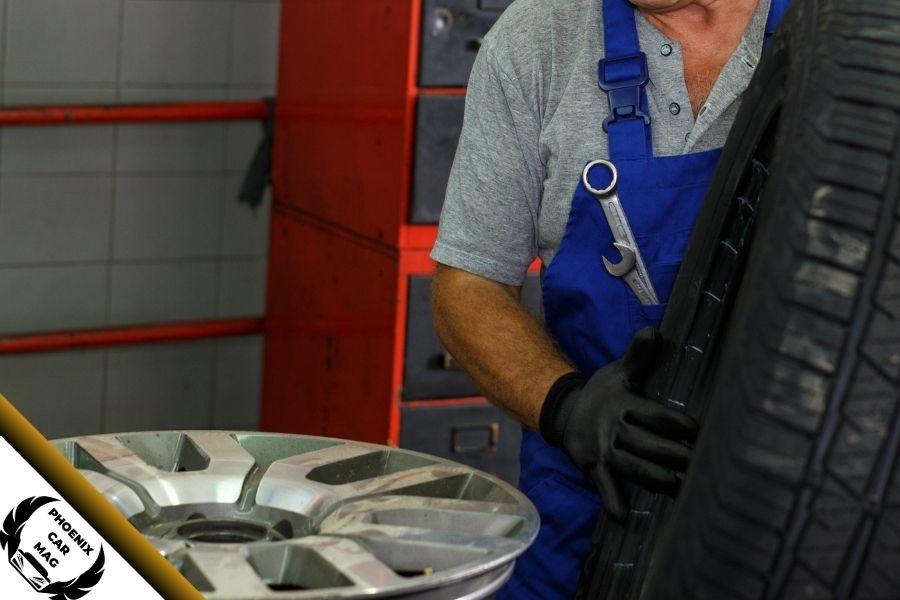
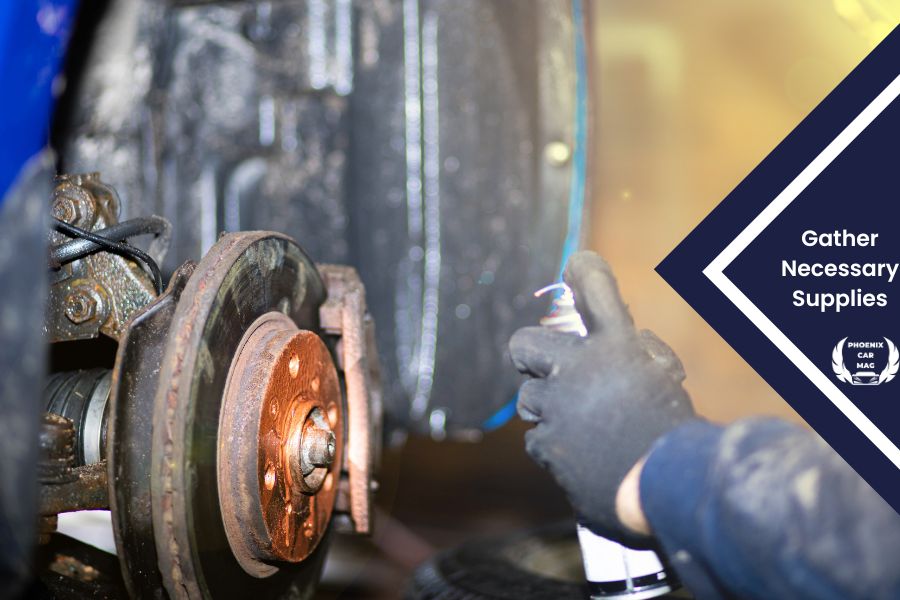
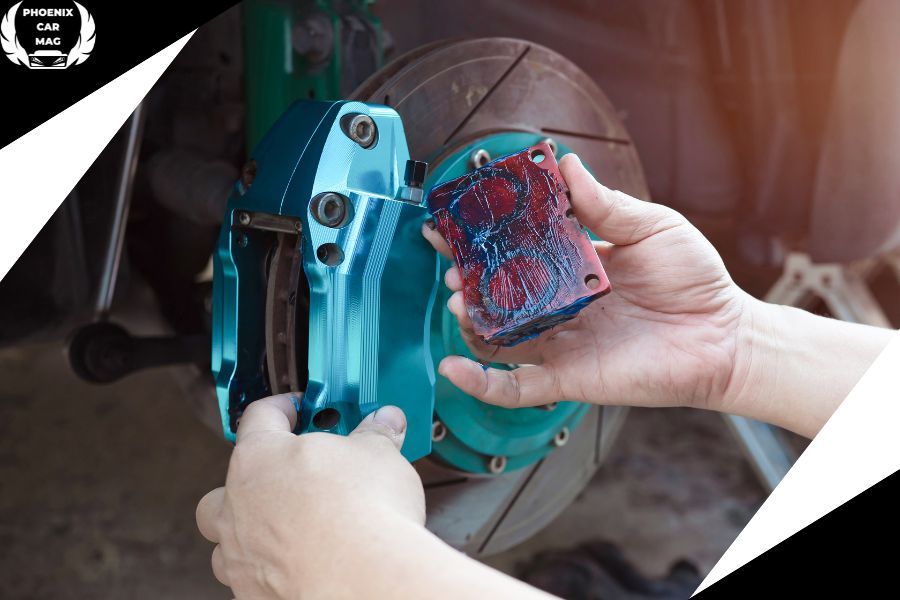
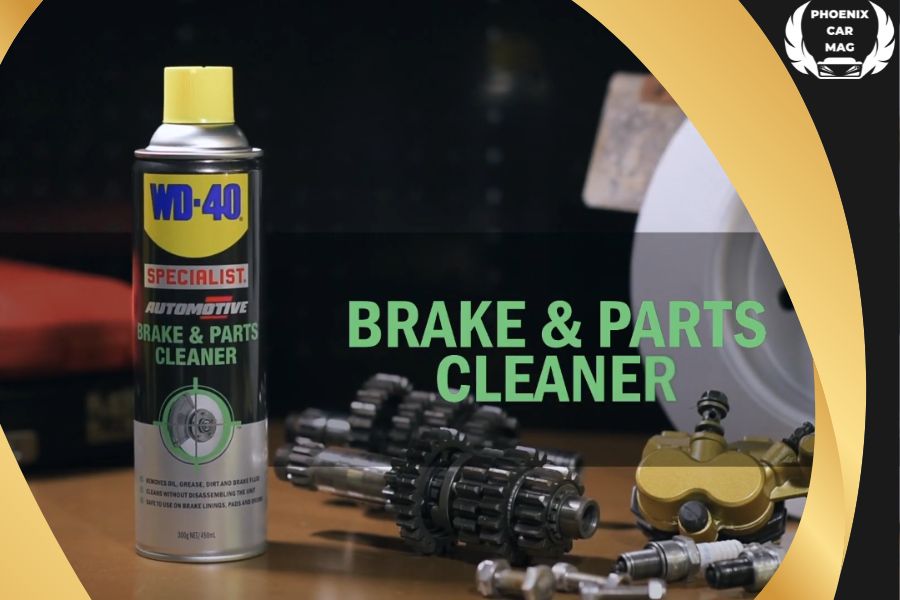
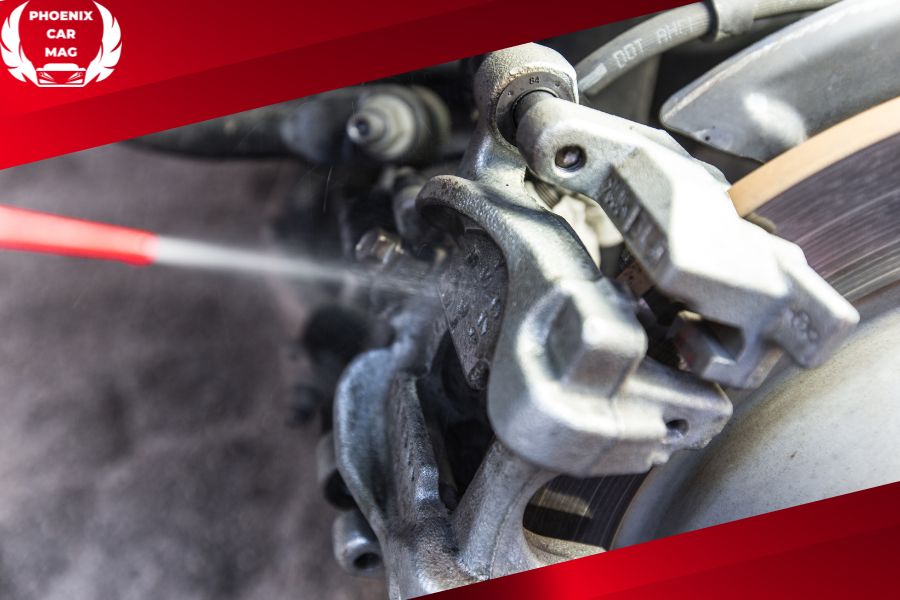
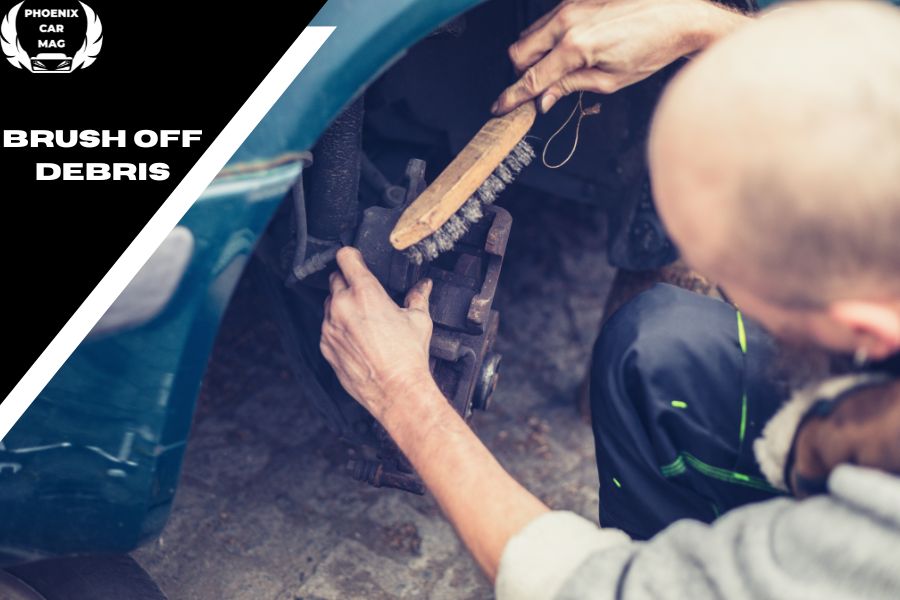


![Brake Fluid Change: Costs + Signs + Everything [2024]](https://phoenixcarmag.com/wp-content/uploads/2024/01/Brake-Fluid-Change-Costs-Signs-Everything-2024-2-308x180.jpg)
![Rear Main Seal Leaking After Replacement [2024 Fixes] Rear Main Seal Leaking After Replacement [2024 Fixes]](https://phoenixcarmag.com/wp-content/uploads/2024/01/Rear-Main-Seal-Leaking-After-Replacement-2024-Fixes.jpg)